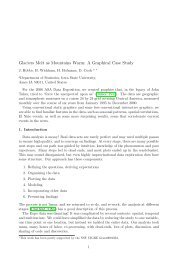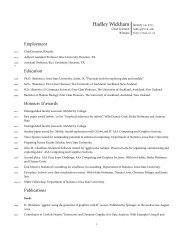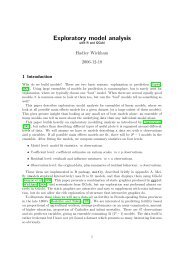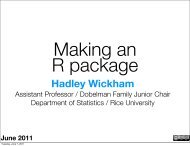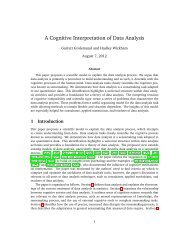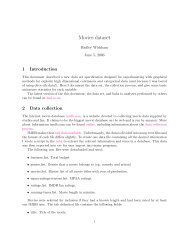Simulation - Hadley Wickham
Simulation - Hadley Wickham
Simulation - Hadley Wickham
Create successful ePaper yourself
Turn your PDF publications into a flip-book with our unique Google optimized e-Paper software.
<strong>Simulation</strong><br />
<strong>Hadley</strong> <strong>Wickham</strong>
•<br />
•<br />
Aims<br />
Learn how to simulate data to:<br />
•<br />
•<br />
•<br />
Test your statistical intuition<br />
Perform power calculation<br />
Experiment with a new technique on<br />
known data<br />
Learn how to use functions to reduce<br />
duplication
•<br />
•<br />
•<br />
•<br />
Basics of simulation<br />
Outline<br />
Don’t repeat yourself<br />
Exploring some theorem you should have<br />
seen before<br />
Exploring the behaviour of a t-test
•<br />
Basics of simulation<br />
Want to:<br />
•<br />
•<br />
generate random numbers from known<br />
distribution<br />
want to repeat the simulation multiple<br />
times
Generating random<br />
numbers<br />
• runif (uniform), rpois (poisson), rnorm<br />
(normal), rbinom (binomial), rgamma<br />
(gamma), rbeta (beta)<br />
•<br />
•<br />
First argument for all is n, number of samples<br />
to generate<br />
Then parameters of the distribution<br />
(always check that the distribution is<br />
parameterised the way you expect)
•<br />
•<br />
•<br />
•<br />
•<br />
Your turn<br />
Generate 100 numbers ~ N(0, 1)<br />
Generate 50 numbers ~ N(10, 5)<br />
Generate 1000 numbers ~ Poisson(50)<br />
Generate 10 numbers ~ Beta(0.1, 0.1)<br />
Generate 30 numbers ~ Uniform(0, 10)
Repetition<br />
• Use the replicate function<br />
• replicate(n, expression)<br />
• replicate(10, mean(rnorm(100)))<br />
• qplot(replicate(100, mean(rnorm(10))),<br />
type="histogram")
•<br />
•<br />
Plot histogram of:<br />
•<br />
•<br />
•<br />
•<br />
Your turn<br />
100 x mean of 10 N(0,1)<br />
1000 x mean of 10 Unif(0, 10)<br />
1000 x mean of 100 Unif(0, 10)<br />
100 x mean of 1000 Unif(0, 10)<br />
What do last three examples show?<br />
Experiment with the number of samples
What your code might<br />
have looked like<br />
• qplot(replicate(100, mean(norm(10))), type="histogram")<br />
• qplot(replicate(10, mean(norm(10))), type="histogram")<br />
• qplot(replicate(1000, mean(norm(10))), type="histogram")<br />
• qplot(replicate(10000, mean(norm(10))), type="histogram")<br />
• qplot(replicate(100, mean(norm(100))), type="histogram")<br />
• qplot(replicate(100, mean(rpois(1000))), type="histogram")<br />
• qplot(replicate(1000, mean(norm(1))), type="histogram")<br />
• qplot(replicate(10000 mean(norm(1000))), type="histogram")
Do not repeat<br />
yourself
Dry rule
•<br />
•<br />
•<br />
Why?<br />
Increases the difficulty of change<br />
May decrease clarity<br />
Leads to opportunities for inconsistency<br />
• http://en.wikipedia.org/wiki/Don't_repeat_yourself
•<br />
Functions<br />
Let us avoid repetition<br />
functionname
•<br />
•<br />
•<br />
•<br />
Building up a function<br />
Start simple<br />
Do it outside of the function<br />
Test as you go<br />
Give it a good name
•<br />
•<br />
•<br />
Your turn<br />
Create a function that draws a histogram of<br />
n replicates of mean(rnorm(100))<br />
Modify your function to draw a histogram of<br />
n draws of mean(rnorm(m))<br />
Modify your function to allow the user to<br />
choose which distribution function, d, to use
•<br />
•<br />
Next task<br />
We know (hopefully) that a t test works<br />
best on normally distributed data<br />
How can we test that?
Your turn<br />
• Figure out how to do a t.test in R<br />
• Figure out how to extract the p-value from<br />
that object (use str and your subsetting<br />
skills)<br />
•<br />
Write a function to generate two vectors of<br />
n random normals, compare them with a<br />
t.test and return the p-value
•<br />
•<br />
•<br />
Your turn<br />
Repeat several thousand times and draw a<br />
histogram for various values of n<br />
Try varying the parameters of the two<br />
normals. What happens when you vary the<br />
mean? What happens when you vary the<br />
standard deviation?<br />
What happens if you use non-normal data?<br />
Eg. uniform, or poisson data
•<br />
•<br />
Another exploration<br />
How does our sample estimate compare to<br />
the true unknown<br />
eg., when calculating the mean of a sample of<br />
random normals, how many do we need to<br />
draw to be reasonably certain we got the<br />
right value?
•<br />
•<br />
•<br />
•<br />
What do we<br />
want to see?<br />
A plot of the different estimates, vs. number<br />
of sample points?<br />
So we need a data.frame with columns n,<br />
and sample mean (and sample sd. as well)<br />
How can we do this?<br />
Can’t just use replicate
New function<br />
• sapply<br />
• Takes first argument, and calls second<br />
argument one at a time<br />
•<br />
•<br />
•<br />
•<br />
sapply(1:10, sum) vs sum(1:10)<br />
sapply(1:10, function(n) mean(rnorm(n))<br />
mean
•<br />
•<br />
•<br />
Create the data<br />
n
•<br />
•<br />
•<br />
•<br />
Your turn<br />
Look at that plot for varying standard<br />
deviations<br />
What about other distributions? eg. poisson<br />
What about when you estimate the standard<br />
deviation?<br />
Try adding smoothed lines to the data (see<br />
qplot chapter mentioned last week)



